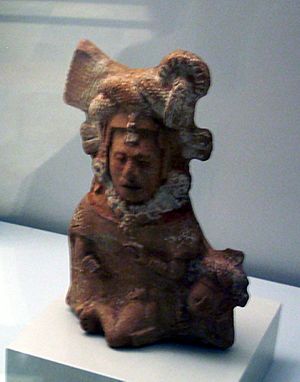Goddess I facts for kids
Goddess I is a very important Maya goddess. She is often shown as a young woman. You can find her in many ancient Maya books, called codices. She also appears in older Maya art.
People believe Goddess I represents important parts of a woman's life. This includes having children and getting married. When she is shown as older, she is linked to weaving. Some think she is like an earthly version of the Maya moon goddess. She is also similar to the Aztec goddess Xochiquetzal.
Contents
What is her name and what does she look like?
The name of Goddess I is written with a special picture-symbol, called a glyph. This glyph shows a woman's head with a curl of hair. This curl might mean "earth" or "moon."
Sometimes, the glyph for "white" (sak) is placed before her name. This is why she is sometimes called the "White Woman." She often wears a coiled snake headband. This is similar to another goddess named Ixchel.
The "White Woman" is different from the "Red Woman." The "Red Woman" is an older goddess linked to helping women give birth. In the ancient Maya books, the roles of women were shared between the White Woman and the Red Woman.
What did she do in ancient Maya calendars?
Goddess I is a main topic in special calendar sections called almanacs. These are found in the Dresden and Madrid codices. She is shown doing different things in these almanacs:
Carrying a bird
Goddess I is sometimes shown carrying a bird on her shoulders. These birds might represent different illnesses. This suggests that Goddess I was seen as a "mother of disease."
Carrying a deity or symbol
She is also shown carrying another god or a special symbol on her back. This symbol or god often gives a hint about the future. For example, she might carry the rain god or a symbol for "abundance."
Holding a god as a child
Sometimes, Goddess I holds another god like a baby on her lap. This might give a prediction about how that child will grow up.
Sitting with another god or animal
Goddess I is often shown sitting across from another god or an animal. These animals include vultures, armadillos, deer, or dogs. These pictures seem to talk about marriage. In the Madrid codex, couples are shown on a reed mat. This mat is a symbol for marriage. The animal or god might show what kind of husband a woman could expect. Goddess I represents the woman in the marriage.
Sitting on another god's lap
This happens only once in the ancient books. Goddess I is shown sitting on the lap of an old god, God L. This might suggest what kind of husband a woman might find. Or it could show how the god influences the woman in a marriage.
How does she compare to other myths?
Goddess I is not always clearly linked to the Maya moon goddess in ancient art. The Moon Goddess often has a rabbit and a crescent moon. However, Goddess I's main roles are similar to the Moon's. The Moon is also strongly linked to water and rain.
In Maya stories, Goddess I has been compared to Xquic. Xquic was the wife of Hun-Hunahpu in the Popol Vuh story. She is also like Po 'Moon', the wife of a deer-hunting hero in another Maya myth. These stories often focus on themes of having children and marriage.
Today, some people think Goddess I might be seen as similar to the Virgin Mary. This is because the Virgin Mary has many different roles in modern Maya religion. She is sometimes seen as a "guardian of maize" (corn).


